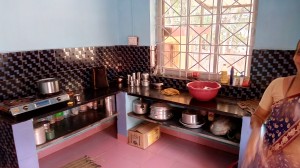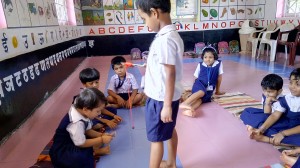 The drought has taken its toll in Goa as well. There were many regions where people received water once in two days through the tankers. One could see several dry wells and ponds. The ones that had water were perhaps not adequately utilized. While moving from south to north Goa, we also came across regions where plantation crops thrived due to abundant irrigation. A few neglected greenhouses bore a testimony to a good idea not pursued vigorously. The biodiversity and the cultural diversity coexisted with great synergy. Notwithstanding the cultural or religious differences, the communities extended a very amiable and affectionate hospitality. The mutual relationship among different communities seemed to bear a great stamp of secular solidarity. The idea competitions among children continued to generate a lot of creativity. So was the case with culinary diversity. There was a free ferry service for commuters across the rivers with remarkable self-regulation on the part of passengers and vehicle owners. There was no sign of one pushing another or trying to load more than the limits. The Goan society taught the shodhyatris a few lessons in social harmony and solidarity with nature.
The drought has taken its toll in Goa as well. There were many regions where people received water once in two days through the tankers. One could see several dry wells and ponds. The ones that had water were perhaps not adequately utilized. While moving from south to north Goa, we also came across regions where plantation crops thrived due to abundant irrigation. A few neglected greenhouses bore a testimony to a good idea not pursued vigorously. The biodiversity and the cultural diversity coexisted with great synergy. Notwithstanding the cultural or religious differences, the communities extended a very amiable and affectionate hospitality. The mutual relationship among different communities seemed to bear a great stamp of secular solidarity. The idea competitions among children continued to generate a lot of creativity. So was the case with culinary diversity. There was a free ferry service for commuters across the rivers with remarkable self-regulation on the part of passengers and vehicle owners. There was no sign of one pushing another or trying to load more than the limits. The Goan society taught the shodhyatris a few lessons in social harmony and solidarity with nature.
However, we also met Rama Vellip, a tribal leader who has been campaigning against haphazard mining for over a decade. Supported by some of the voluntary organisations, he succeeded in supreme court order for a three year ban on mining. It is hoped that when mining is resumed, it will be with much more responsibility towards nature and the rights of tribal and other people. A typical practice of cutting old trees from some of these mining sites to plant fast growing species was followed in many places. Such places then were exempted from forest regulations. The leaders like Rama Vellip have resisted various corrupting allurements. We also came across sand mining in the river where workers from eastern UP earn more than Rs.500 per day. A small innovation in the sand pan was very instructive. There were four holes in the top side of the pan with knotted rope hanging out. While lifting the pan with sand, it became easier for two people to hold two handles each. This practice can easily be adopted in many other sites for construction or carrying head loads of other kinds.

An outstanding anganwadi in Betki village won our heart. There were outstanding kitchen and classroom facilities for children. I wish every anganwadi of the country will be as well furnished as here. Only in Sikkim, we had come across equally beautiful anganwadi. If young children get exposure to a caring and nurturant environment early in life, they would hopefully contribute much more to the nation building than otherwise. The quality of schools in which we often stayed was also equally good. In some places, the grills had alphabets welded onto them. When you look through the window, you cannot escape shapes which teach.
Dr. Duttaram Desai, Savaiveri village had mobilized a large number of volunteers to clean the village pond. If every pond of the country is cleaned and desilted in the next fortnight, we would have stored trillions of litters of water all over the country recharging wells and supporting the ecosystem. Sahil had modified ordinary car with many additional features of high end cars. Komal Desai, originally from Karnataka border village, shared beautiful examples of vegetable art. Kokam oil [Garcinia indica] was used in many houses to apply on the bread. A lot of poor people could be seen collecting kokam fruits and seeds. A very effective antioxidant, anti-flatulent, coolant fruit saves us from the heatstroke. To fight the current heat wave, kokam could be your best friend. One should avoid consuming milk at least after an hour of consuming kokam because of its acidic content.
Dr. Lalat and his student volunteers from NIT Goa were extremely helpful in organizing the 37th shodhyata. We have relished the hospitality of local communities like never before and we hope that their social solidarity continues to inspire us in centuries to come. The natural sculptures in the forest were a treat for our spirit. We only hope that the likely thrust on mining in future doesn’t destroy more mountains, forests, water bodies and even social fabric.
 Where else have we seen more doctors than patients in the hospital. It is a healthy, happy and helpful culture which one can experience only when goes beyond the bar and the beeches. The areas where significant improves can take place include farm machinery, water management, sanitation, conservation, etc. Every company selling beer or liquour should be made responsible for collecting all the bottles and cans lying on the roadside and sometime in the forest. This was one of the most unfortunate side effect of prosperity. At the aggregate level, Goa may have less than five per cent of coconut market share. But, the machinery used to process was very primitive. There is a considerable scope for introducing innovative coconut husking machines for which NIF has already started the efforts. There is a scope for organic agriculture. Many plantations didn’t use chemical pesticides. There could be many more experiments to support the strength. The innovations in food processing machineries was another area where the Honey Bee database could be very helpful. The shodhyatris showed the films of different innovations during the night meetings. We hope that both local and external innovations improving the productivity in a labour scarce economy will find policy and institutional support in future.
Where else have we seen more doctors than patients in the hospital. It is a healthy, happy and helpful culture which one can experience only when goes beyond the bar and the beeches. The areas where significant improves can take place include farm machinery, water management, sanitation, conservation, etc. Every company selling beer or liquour should be made responsible for collecting all the bottles and cans lying on the roadside and sometime in the forest. This was one of the most unfortunate side effect of prosperity. At the aggregate level, Goa may have less than five per cent of coconut market share. But, the machinery used to process was very primitive. There is a considerable scope for introducing innovative coconut husking machines for which NIF has already started the efforts. There is a scope for organic agriculture. Many plantations didn’t use chemical pesticides. There could be many more experiments to support the strength. The innovations in food processing machineries was another area where the Honey Bee database could be very helpful. The shodhyatris showed the films of different innovations during the night meetings. We hope that both local and external innovations improving the productivity in a labour scarce economy will find policy and institutional support in future.

